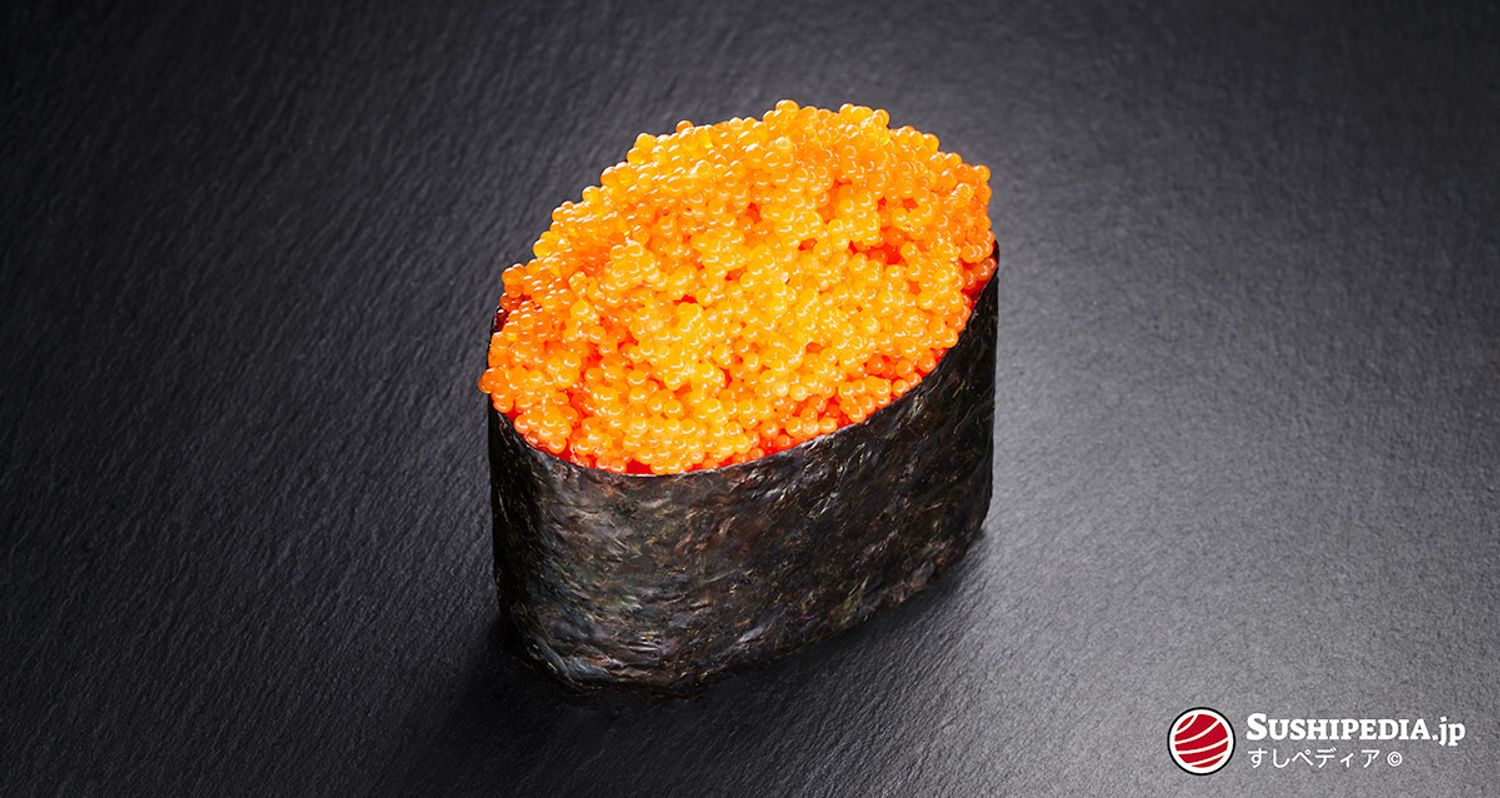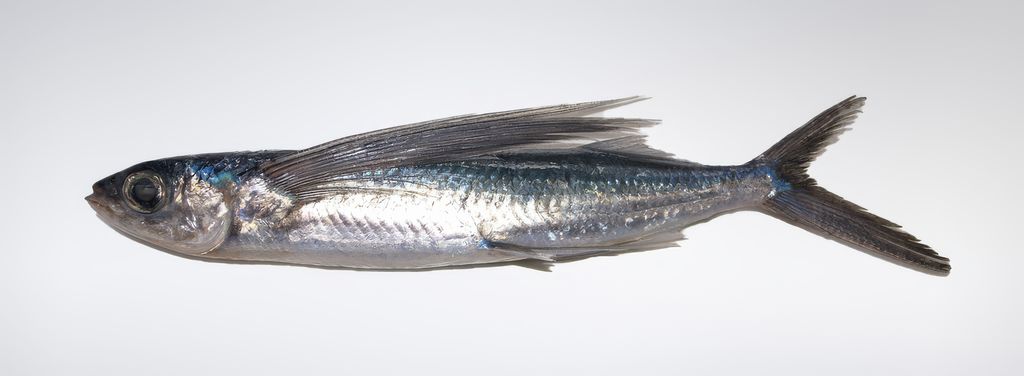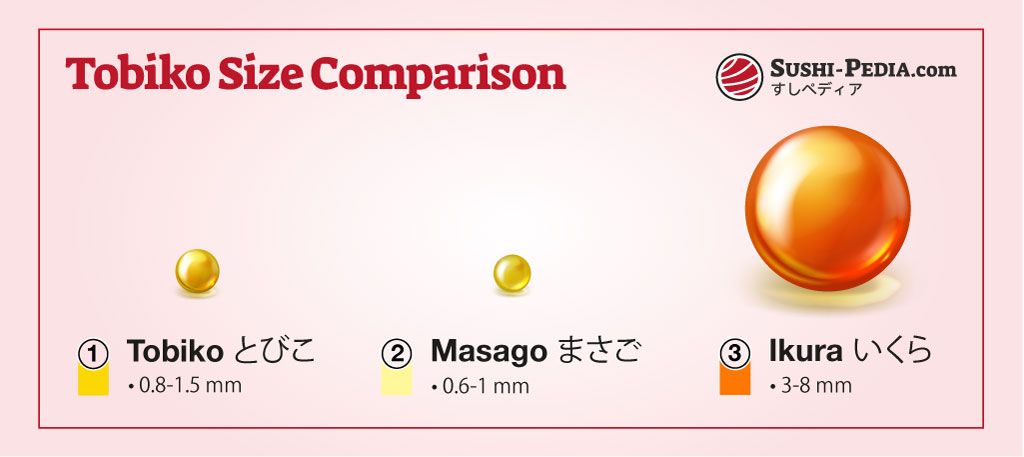Tobiko Sushi
A Comprehensive Overview of Flying Fish Caviar, Roe from Flying Fish in Japanese Sushi Cuisine
トビコすし 、 飛子寿司 
What is Tobiko?
Tobiko is the Japanese name for the roe of flying fish, which are known for their ability to glide through the air close above and parallel to the water surface. Flying fish roe is one of the most widely consumed types of fish roe in Asia.[1] Tobiko is often used in Japanese cuisine for the preparation of sushi and as a garnish for other dishes. In Japan, tobiko is also occasionally called “golden caviar” (gōruden-kyabia).[2] It is a popular ingredient, especially for “western-style sushi” or non-traditional fusion cuisine.
Tobiko for Sushi or Sashimi
Tobiko is produced by salting the roe of flying fish. The eggs, which are about 2 millimeters in size, are golden and have a hard shell, so they will not crack until a little pressure is applied.[1] The crunchy and juicy feeling is accompanied by subtle salty aromas reminiscent of the sea.
While tobiko as gunkan maki sushi does not have the same significance as ikura in sushi gastronomy, it is commonly used in non-traditional and western-style sushi dishes. Although tobiko can serve as the filling of a gunkan maki, it is most often used as a garnish or side dish. It is regularly used to prepare sushi that is rolled inside-out. In addition to preparation as uramaki, such as the California roll, tobiko is appreciated in Japanese cuisine as a combination with avocado, cucumber, or mayonnaise.
Besides the natural golden coloration, there are also different colored variants of tobiko. These range from eggs blackened with sepia to bright yellow eggs, which owe their color to the dyes of citrus fruits. Commercially available tobiko comes almost exclusively from industrial mass production and is usually extensively treated with colorants, preservatives, and flavors.
Best Season
Flying fish are found in the tropical and subtropical regions of the Atlantic and Pacific Ocean, which means that the spawning season varies according to species and region. For example, the Japanese flying fish spawns on the coasts of Japan in the warm months from May to September, and the same species spawns in the South Pacific near Fiji at exactly the opposite time of year [3].
Pasteurized and salted tobiko can be stored under refrigeration for several months without significant loss of quality.
Types of Tobiko
Golden Tobiko
The natural color of the roe of the flying fish is a golden to light yellow-orange.[1] This original shade remains largely untouched by modern processing or preservation processes. Compared to the colored and flavored tobiko variations, it has a more subtle and delicate taste. In the market you often find golden tobiko that has been treated with natural curcumin (C.I. Natural Yellow 3, E100), yellow-orange food coloring (FD&C Yellow 6, E110) or ginger flavoring. In order for golden tobiko to have an authentic taste of high quality, it should not contain any preservatives, colorants, or flavorings other than salt. Occasionally, tobiko is additionally flavored with Japanese rice wine vinegar.
Yellow Tobiko
Yellow tobiko is traditionally colored with yuzu, a citrus fruit common in East Asia. In addition to yuzu, other citrus fruits are also used, such as citron. With natural colorants, yellow colored tobiko is rarely found in the trade. The majority of industrially produced yellow tobiko is colored with food colorants (FD&C Yellow No.6, E110, capsanthin, E160c) and to some extent enriched with ginger flavors.
Green Tobiko
Tobiko treated with genuine wasabi or its oil is greenish in color and intense in taste. There are many products on the market whose bright green color comes from food colorants. This striking green is often created by mixing and adding lemon yellow tartrazine (C.I. Food Yellow 4, E102) and brilliant blue (C.I. Food Blue 2, E133).
Orange Tobiko
The orange tobiko is reminiscent of the color of the roe of salmonids and is traditionally obtained by adding soy sauce. The orange variant represents the most commonly used tobiko. Besides the traditional coloring, the bright orange is regularly the result of the addition of food coloring. For this purpose, mainly yellow to orange tartrazine (FD&C Yellow 5, E102), yellow orange (FD&C Yellow 6, E110) and allura red (FD&C Red 40, E129) are used.
Red Tobiko
Red tobiko has a bright red coloration, which can be produced by coloring with beet or paprika extracts. The taste is less subtle and spicy. The hue of industrially produced red tobiko is usually produced by adding allura red (FD&C Red 40, E129).
Black Tobiko
By adding cephalopod ink or sepia, the dye extracted from the ink bag of squid or cuttlefish, tobiko turns dark. The use of squid or cuttlefish ink is found only in very few high quality products. For the industrial production of black tobiko, mainly brilliant blue (FD&C Blue No. 1, E133), brilliant black (FD&C Food Black 1, E151) and vegetable carbon (C.I. Pigment Black 6, E153) are used. The use of E151 and E153 is not permitted as food colorant in the United States of America and Japan.[4][5]
Tobiko in Japan
The Japanese term tobiko is composed of 飛, the sign for “flying” and the sign 子 which stands for “child”. The word tobiko is derived from tobiuo トビウオ, the Japanese name for a flying fish. By adding the word “child” (ko) the offspring of the previous term is described, in this case the roe of the flying fish (tobiuonoko or tobi-ko).[6]
Characteristics & Ecology of Tobiko

South Atlantic Meridional Overturning Circulation (SAMOC). Flying fish shortly after take-off. All rights reserved ©
Flying fish can be found in tropical and subtropical waters all over the world. In several parts of the world, they are an integral part of the epipelagic food chain and a valuable fishery resource.[7] In the seas surrounding the Japanese archipelago, many species of flying fish are found. Therefore, no species can be identified specifically for tobiko. However, the Japanese flyingfish (tobiou), the darkedged-wing flyingfish (hoso tobiuo) and the glider flyingfish (aka tobiou) should be emphasized due to their importance.

Dieno. Cheilopogon pinnatibarbatus japonicus (Franz, 1910). wikimedia.org. Some rights reserved: Public Domain
According to current scientific knowledge, the total number of species of flying fish is estimated to be between 60 and 70. Among these species, a distinction is made between two-winged and four-winged species. The two-winged flying fishes glide using their enlarged pectoral fins, while the four-winged flying fishes also use their enlarged pelvic fins, which contribute to their gliding ability. To escape predators, the flying fish can glide long distances above the water's surface. As a result, over the course of evolution, flying fish have evolved into slender and streamlined animals. Their reinforced lower jaw is another adaptation that prevents the fine jaw bones from being damaged when they enter the water at high speed.[8]

SushiPedia. Size Comparison of Sushi Ingredients: Tobiko, Masago, and Ikura. All rights reserved ©
The eggs of flying fish are not buoyant and have long sticky threads that serve to attach the eggs to floating objects. Flying fish roe is harvested by taking advantage of this natural behavior. Harvesting is therefore carried out by using stationary or floating structures of various types, in which the females of the flying fish deposit their roe, which is then collected by fishermen.[3]
Video about Tobiko Sushi
External video embedded from: youTube.com. Credit 掃街茂 Street Fighter. Making of Tobiko Sushi とびこの軍艦巻 (とびこ) Flying Fish Roe Sushi 飛魚子壽司 飛魚子軍艦巻(蟹子壽司)MVI 0449.
Species for Tobiko
The following species are regarded as authentic tobiko. Either historically, according to the area of distribution or according to the common practice in today's gastronomy: The term tobiko encompasses a variety of species that are grouped together under these names. Due to the extensive diversity of these species, it is not always possible to list all specific taxa in this list completely.
In the following, those species are listed that can be considered as substitutes for authentic species with regard to tobiko. This can be based either on their genetic relationship or on their similarity in taste and appearance. The selection is subjective and is not strictly based on Japanese conventions, but also takes into account the practices in the respective areas where the Japanese dishes are prepared. This flexible approach allows for adaptation to local availability and preferences while preserving the core flavor and texture traditionally associated with tobiko.
Sources and Further Reading
- [1]G.E. Bledsoe , C.D. Bledsoe & B. Rasco. Caviars and Fish Roe Products. Critical Reviews in Food Science and Nutrition 43 (3) 317-356. 2003. DOI: 10.1080/10408690390826545.
- [2]『アサヒグラフ 3808 – 3815』. 朝日新聞社. 1995
- [3]Robert Gillett, James Ianelli. Flyingfish, FFA Report 92/56. Pacific Islands Forum Fisheries Agency (FFA), Honiara. 1992
- [4]Issues And Concerns With Imported Foods, Food Color Additives Banned In The USA. Association Of Food And Drug Officials (AFDO), York. 2019
- [5]List of Designated Additives. The Japan Food Chemical Research Foundation (FFCR). 2020
- [6]Yoshino Masuo. Sushi. Gakken Co. Ltd., Tokyo. 1987
- [7]Hazel A. Oxenford, Robin Mahon, Wayne Hunte. Distribution and relative abundance of flyingfish (Exocoetidae) in the eastern Caribbean. I. Adults. Marine Ecology Progress Series 11 11-23. 1995
- [8]Steve N. G. Howell. The Amazing World of Flyingfish. Princeton University Press, Princeton. 2014
- Bom-Bi Ha, Eun-Hee Jo, Suengmok Cho, Seon-Bong Kim. Production optimization of flying fish roe analogs using calcium alginate hydrogel beads. Fisheries and Aquatic Sciences 19 (30). 2016. DOI: 10.1186/s41240-016-0031-y.
- Furukawa Tomoko (古川知子). Healthy Food Encyclopedia (食材健康大事典). Jiji Press, Tokyo (時事通信出版局, 東京都). 2005
- Gøril Voldnes. On the hunt for flying fish. Sciencenorway.no, Oslo, 2019-04-02. Source retrieved 12/27/2020
- Richard Evershed, Nicola Temple. Sorting the Beef from the Bull: The Science of Food Fraud Forensics. Bloomsbury Publishing, London. 2016
- Tara L. Casazza, Steve W. Ross, Ann Marie Necaise, Kenneth J. Sulak. Reproduction and mating behavior of the atlantic flyingfish, Cheilopogon melanurus (Exocoetidae), off North Carolina. Bulletin of Marine Science 77 (3). 2005
- IUCN Red List of Threatened Species. Version 2023-1
Image Credits
- SushiPedia. Size Comparison of Sushi Ingredients: Tobiko, Masago, and Ikura. All rights reserved ©
- SushiPedia. Tobiko Gunkan Maki. All rights reserved ©
- South Atlantic Meridional Overturning Circulation (SAMOC). Flying fish shortly after take-off. All rights reserved ©